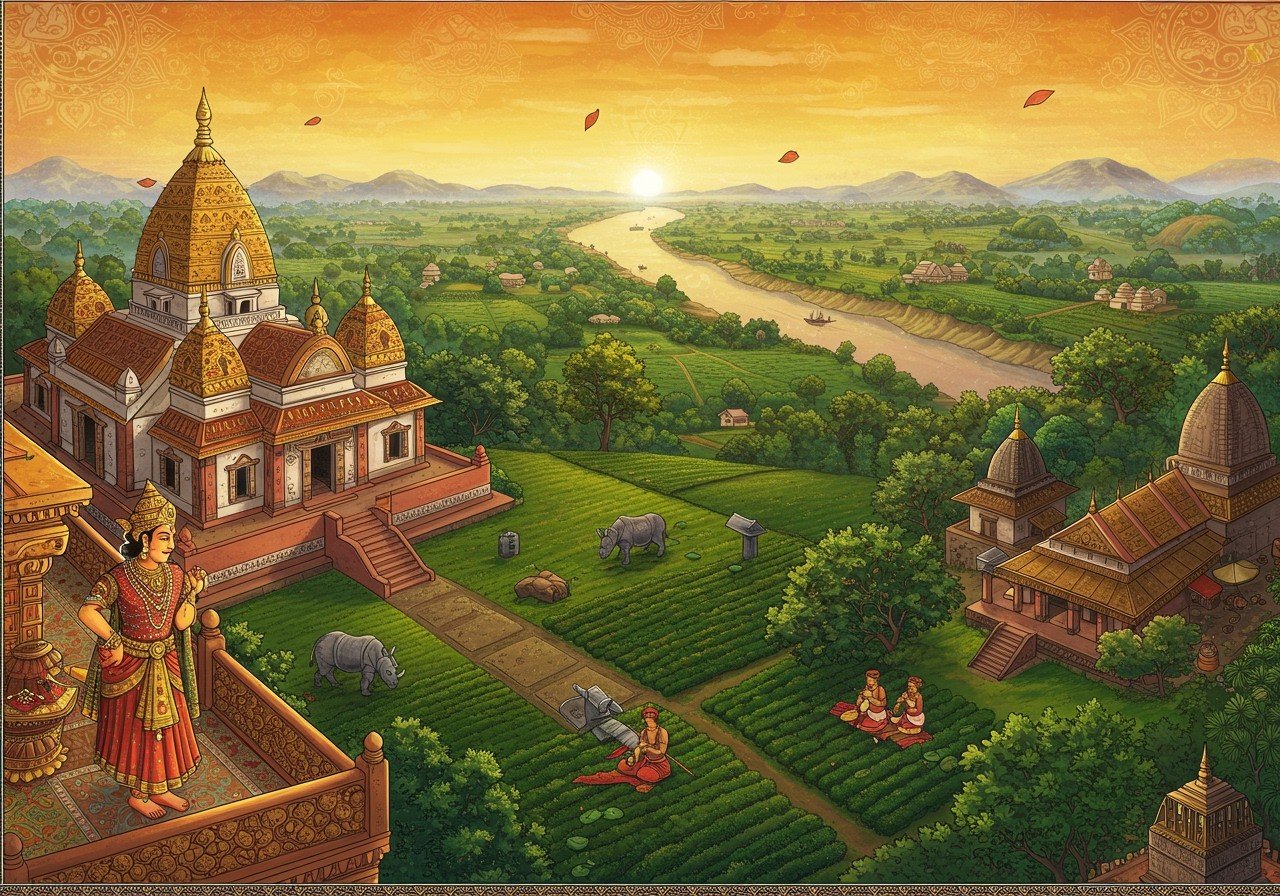
Kamarupa, an ancient kingdom nestled in present-day Assam, India, boasts a vibrant tapestry of history and culture. Flourishing from the 4th to the 12th century CE, it played a pivotal role in shaping Northeast India’s cultural and historical trajectory. This blog post delves into the captivating history, influential rulers, significant battles, and rich cultural heritage of Kamarupa, providing a comprehensive understanding of its enduring significance.
Origins and Rise of a Kingdom
Kamarupa’s origins are steeped in mythology, with references in ancient Hindu texts like the Mahabharata and the Puranas. Established around the 4th century CE, the kingdom derived its name from the revered deity Kamakhya, a central figure in local religious practices. The early rulers, belonging to the Varman dynasty, laid the foundation for Kamarupa’s distinct political and cultural identity, uniting diverse tribes and clans under a centralized administration.
The Varman Dynasty: Architects of Kamarupa
The Varman dynasty, founded by Pushyavarman around the 4th century CE, marked the beginning of Kamarupa’s documented history. This dynasty made significant contributions to art, architecture, and the propagation of Hinduism. Bhaskaravarman, one of the most renowned Varman rulers, played a pivotal role in shaping Kamarupa’s cultural and political landscape, forging diplomatic ties with Harshavardhana, the powerful ruler of Kannauj. The Varmans were celebrated for their administrative acumen and military prowess, which enabled them to expand and secure the kingdom’s boundaries.
Bhaskaravarman’s Reign: A Golden Age
Bhaskaravarman, who reigned from 600 to 650 CE, is regarded as one of Kamarupa’s most illustrious kings. His reign witnessed a flourishing of art, literature, and religious practices. Bhaskaravarman’s alliance with Harshavardhana significantly enhanced Kamarupa’s political influence. Known for his patronage of scholars and cultural endeavors, his rule ushered in an era of stability and prosperity, transforming Kamarupa into a hub of cultural and intellectual exchange.
The Pala Dynasty: Guardians of Tradition
Following the decline of the Varman dynasty, the Pala dynasty emerged as the next significant ruling house of Kamarupa. Beginning with Brahma Pala, these rulers preserved the region’s cultural and religious traditions. The Palas fostered the development of Buddhist practices alongside Hinduism, maintaining the kingdom’s stability amidst external threats. They played a key role in constructing temples and promoting indigenous art forms.
Military Conflicts: Defending the Realm
Kamarupa’s history is punctuated by significant battles and military conflicts. Its strategic location made it a coveted target for neighboring powers. Bhaskaravarman, in particular, is remembered for his valiant defense of the kingdom against external invasions. The military strategies employed by Kamarupa’s rulers were crucial in safeguarding its sovereignty. These conflicts shaped political alliances and diplomatic relations with other regions, leaving an indelible mark on Kamarupa’s historical narrative.
Administrative Divisions: The Four Pillars of Kamarupa
Ancient Kamarupa was divided into four distinct regions: Kamapitha, Ratnapitha, Langapitha, and Dakshinapatha. Each division possessed unique cultural and administrative significance. Kamapitha was renowned for its sacred sites, including the famed Kamakhya Temple. Ratnapitha thrived as a center of trade and commerce. Langapitha played a vital role in agricultural production, while Dakshinapatha held strategic importance due to its geographical location. These divisions facilitated efficient governance and contributed to the kingdom’s stability.
Cultural Heritage: A Tapestry of Traditions
Kamarupa’s cultural heritage is a rich tapestry interwoven with diverse traditions and practices. The kingdom made significant contributions to classical music, dance, and literature. Ancient texts and inscriptions provide valuable insights into the religious practices and societal norms of the era. Architectural marvels, such as temples and fortifications, stand as testaments to the artistic ingenuity of the people. This cultural heritage continues to resonate in the traditions and rituals of present-day Assam.
Mapping Kamarupa: Unraveling the Past
Understanding Kamarupa’s geographical extent requires careful study of ancient maps and historical records. The kingdom encompassed present-day Assam and parts of Bangladesh and Bhutan. Its capital, Pragjyotishpura, is now known as Guwahati. Ancient maps reveal the strategic locations of forts, temples, and trade routes, which played crucial roles in defense and economic activities. Mapping Kamarupa provides insights into the historical significance of various sites and their contributions to the kingdom’s enduring legacy.
Exploring Assam’s Spiritual Heritage with Poojn.in
Poojn.in, India’s leading online store for cultural and religious goods, offers a wide selection of products to connect you with Assam’s rich spiritual heritage. Whether you are seeking traditional Assamese puja items or exploring the rituals of Kamarupa, Poojn.in provides a convenient platform to discover authentic products and deepen your understanding of these sacred traditions.
- Authentic Puja Items: Discover a diverse range of puja samagri, including diyas, incense, and offerings, specifically curated for traditional Assamese rituals. Explore our collection of Dor Mala sets, perfect for your puja needs.
- Connect with Tradition: Immerse yourself in the spiritual practices of Kamarupa with our selection of incense, handcrafted idols, and other essential puja items. Find exquisite marble dust sculptures and idols to enhance your spiritual practice.
Conclusion: Kamarupa’s Enduring Legacy
Kamarupa’s rich history and cultural heritage continue to inspire and intrigue. From its powerful rulers and strategic battles to its vibrant artistic traditions and administrative innovations, Kamarupa has left an indelible mark on Assam’s identity. By exploring this ancient kingdom’s story, we gain a deeper appreciation for the historical and cultural foundations that have shaped the region we know today.
FAQs on Kamarupa
What made Bhaskaravarman a key figure in Kamarupa’s history? Bhaskaravarman’s diplomatic alliances and patronage of the arts significantly strengthened Kamarupa’s political and cultural standing. His reign is considered a golden age in the kingdom’s history.
What is the significance of the Varman dynasty? The Varman dynasty laid the foundation for Kamarupa’s documented history, contributing significantly to its administration, cultural development, and expansion.
What were the four administrative divisions of ancient Kamarupa? Ancient Kamarupa was divided into Kamapitha, Ratnapitha, Langapitha, and Dakshinapatha, each with unique cultural and administrative roles.
Where was the capital of ancient Kamarupa? Pragjyotishpura, present-day Guwahati, served as the capital of ancient Kamarupa, a hub of administration and cultural activity.


